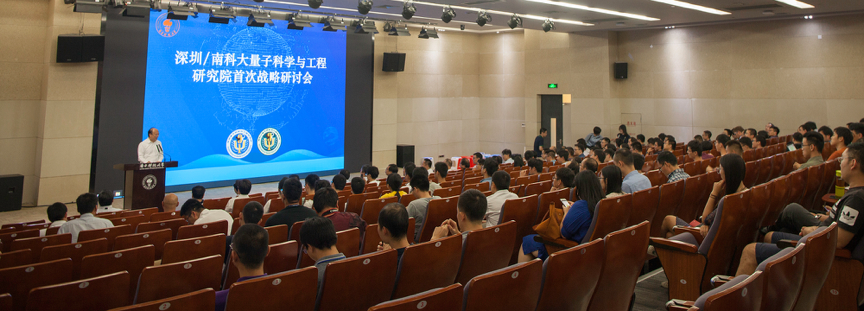On September 28, 2018, the first strategic seminar of Shenzhen/SUSTech Institute for Quantum Science and Engineering was held at Southern University of Science and Technology (SUSTech). SUSTech President and Academician of the Chinese Academy of Sciences (CAS) Chen Shiyi joined other CAS academicians like Vice President of the University of Science and Technology of China Pan Jianwei, Dean of the Shenzhen/SUSTech Institute for Quantum Science and Engineering Yu Dapeng. Other attendees included Deputy Director of the Guangdong Provincial Department of Science and Technology Zheng Haitao and Deputy Director of the Shenzhen Science and Technology Innovation Committee Zhong Hai. The meeting was hosted by SUSTech President Chen Shiyi.

University President Chen Shyi spoke at the meeting. He said that he expects quantum technology to become the core of the fourth industrial revolution. SUSTech would give strong support to the Shenzhen/SUSTech Institute for Quantum Science and Engineering.
In his speech, Guangdong Deputy Director Zheng Haitao expressed his support for the innovation and development of quantum technology in Guangdong Province. He said that he would cooperate with experts in the field of quantum technology at home and abroad to serve China’s national quantum technology strategy. He believed that it was important to provide policy support, platform construction, special independent support and personnel introduction services for the development of quantum technology.
Shenzhen Deputy Director Zhong Hai said that Shenzhen’s rapid economic development in the past few decades and the rapid improvement of the strength of the University in recent years are a miracle, I believe that Shenzhen can continue to create miracles in science and education. The Shenzhen Science and Technology Commission would provide a strong guarantee for the development of the Quantum Institute.
At the meeting, Pan Jianwei was appointed as the director of the Academic Committee of the Shenzhen/SUSTech Institute for Quantum Science and Engineering and a member of the Management Committee. Zhong Hai was the deputy director of the Management Committee.
In the subsequent lecture, Pan Jianwei spoke about the “basic testing of quantum physics to quantum information technology.” His lecture introduced the development of quantum communication, quantum computation and simulation, and quantum precision measurement. Other areas included intercontinental quantum communication experiments and systematic research on various physical systems, which are expected to realize scalable quantum information processing.
Yu Dapeng reported on the progress and planning of the preparatory work of the Institute of Quantum Science and Engineering. He detailed the research process from preparation for development, current achievements and future planning. He expressed gratitude to the Shenzhen Municipal Government and SUSTech for their support and said that the Institute would try its best to meet the economy of Shenzhen and Greater Bay Area. Yu Dapeng added that the Institute would strive to meet the development needs of China and strive to make original work worthy of the Nobel Prize.
Director of the Topological Quantum Computing Excellence Center of the Chinese Academy of Sciences Zhang Fuchun, Vice-President of Sun Yat-sen University Wang Xuehua, Chief Engineer of the Guangzhou Overcalculation Center Du Yunfei, were among key government and educational figures in attendance. Representatives from Guangdong Science and Technology Department, Shenzhen Science and Technology Creation Commission, and Longhua District Science and Technology Innovation Bureau were joined by university representatives from institutions such as SUSTech, Hong Kong University, Hong Kong University of Science and Technology, Chinese University of Hong Kong, Hong Kong City University, Chinese Academy of Sciences, China University of Science and Technology, Shanghai Jiaotong University, Sun Yat-sen University, South China Normal University and Shanxi University.
Proofread ByXia Yingying
Photo ByShenzhen Institute of Quantum Science and Engineering